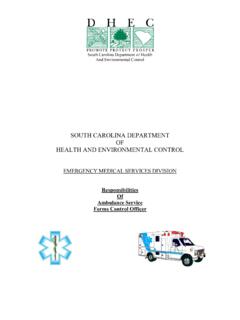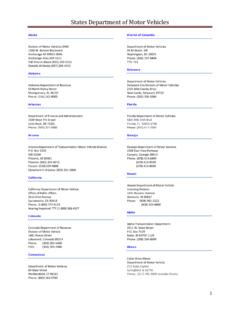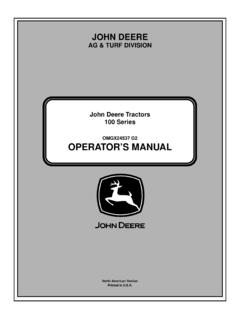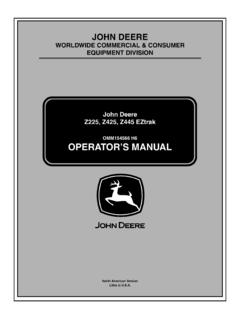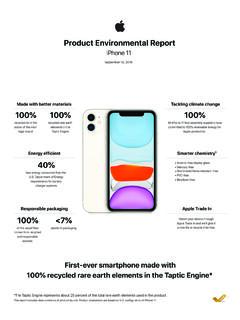Transcription of Commercial Medium- and Heavy-Duty Truck Fuel Efficiency ...
1 DOT HS 812 194 February 2016 Commercial Medium- and Heavy-Duty Truck Fuel Efficiency Technology Study Report #2 This publication is distributed by the Department of Transportation, National Highway Traffic Safety Administration, in the interest of information exchange. The opinions, findings and conclusions expressed in this publication are those of the author and not necessarily those of the Department of Transportation or the National Highway Traffic Safety Administration. The United States Government assumes no liability for its content or use thereof. If trade or manufacturers names or products are mentioned, it is because they are considered essential to the object of the publication and should not be construed as an endorsement.
2 The United States Government does not endorse products or manufacturers. Suggested APA Format Citation: Reinhart, T. E. (2016, February). Commercial medium- and Heavy-Duty Truck fuel Efficiency technology study Report #2. (Report No. DOT HS 812 194). Washington, DC: National Highway Traffic Safety Administration. i TECHNICAL REPORT DOCUMENTATION PAGE HS 812 194 Accession 's Catalog and SubtitleCommercial Medium- and Heavy-Duty Truck Fuel Efficiency Technology Study Report #2 DateFebruary 2016 Organization (s) Thomas E. Reinhart, Institute Engineer Organization Report Project No. Organization Name and AddressSouthwest Research Institute 6220 Culebra Rd. San Antonio, TX 78238 Unit No. (TRAIS) or Grant Agency Name and AddressNational Highway Traffic Safety Administration 1200 New Jersey Avenue SE.
3 Washington, DC 20590 of Report and Period CoveredFinal Technical Report Agency CodeNHTSA/NRM-320 NotesPrepared for: James MacIsaac (COR) Dr. John Whitefoot (Alternate COR) Department of Transportation National Highway Traffic Safety Administration Fuel Economy Division, NVS-132 1200 New Jersey Avenue SE. Washington, DC 20590 Coralie Cooper Department of Transportation Volpe National Transportation Systems Center Energy Analysis and Sustainability Division 55 Broadway Cambridge, MA 02142-1093 This research project is to inform NHTSA and EPA s development of Phase 2 Greenhouse Gas emissions and Fuel Efficiency Standards for Medium- and Heavy-Duty Engines and Vehicles (Class 2b 8). A preceding report (Report #1) evaluated individual potential engine and vehicle fuel savings technologies over a wide range of duty cycles.
4 This report evaluates the effectiveness of packages of those individual technologies as well as other related topics. After an introduction, Section 2 includes fuel consumption simulation results for both engine and vehicle technology packages in Class 2b through Class 8 trucks. Section 3 describes the results of parameter sweep studies, covering aerodynamic drag, tire rolling resistance, vehicle empty weight, and axle ratios. Section 4 covers a brief review of vocational Truck specification issues, and Section 5 is a survey of natural gas vehicle costs, along with some implementation issues for natural gas powered vehicles. Section 6 provides an overview of overall performance simulation project conclusions.
5 Note: This report was subjected to external peer review per OMB guidelines for a Highly Influential Scientific Assessment (HISA). Materials from the peer review process are publicly available in accompanying documents. WordsFuel consumption, GHG emissions , medium duty, heavy duty, engine simulation, vehicle simulation, hybrid vehicles, vocational Truck , Truck specification, natural gas Truck , natural gas Truck cost StatementDocument is available to the public from the National Technical Information Service Classif. (of this report) Unclassified Classif. (of this page) Unclassified of Pages 276 DOT F (8-72) Reproduction of completed page authorized ii EXECUTIVE SUMMARY In 2011, the National Highway Traffic Safety Administration and Environmental Protection Agency (EPA) jointly issued a first phase of fuel Efficiency and greenhouse gas (GHG) standards that apply to medium- and Heavy-Duty on-highway engines and vehicles for model years (MY) 2014 to 2018 and beyond.
6 These regulations are commonly referred to as Phase 1 of the Heavy-Duty National Program. The standards cover all vehicles in weight classes 2b through 8, which encompasses most vehicles with gross vehicle weight ratings (GVWR) over 8,500 pounds except for a limited number of passenger vehicles covered under the light duty corporate average fuel economy (CAFE) standards, and recreational vehicles, which were included in EPA s GHG standards but not NHTSA s fuel Efficiency standards. Phase 1 has two implementation stages. EPA s greenhouse gas emission standards are mandatory beginning with MY 2014. NHTSA s fuel consumption standards are voluntary in model years 2014 and 2015, becoming mandatory with model year 2016 for most regulatory categories.
7 Commercial trailers were not regulated in Phase 1. The Phase 1 GHG and fuel consumption standards were developed using input from a number of studies that evaluated the fuel saving technologies that are available, such as the NESCCAF 2009 report [1] and the NHTSA and NAS 2010 reports [2], [3]. The research project described in this report has been completed for NHTSA to help to inform the next phase ( Phase 2 ) of the regulations, which would set standards in coordination with EPA for model years beyond Phase 1. In order to prepare for Phase 2, NHTSA directed SwRI to update prior research on fuel saving technologies to reflect the effects of the Phase 1 regulations, as well as to include technical progress that has been made over the last few years.
8 In particular, SwRI was tasked with assessing the current Commercial fleet technology baseline at the time of contract award (MY 2011/2012) and assessing the effectiveness and cost of potential fuel Efficiency /GHG improving technologies for the Phase 2 timeframe (post MY 2018 for vehicles and engines). When considering potential fuel Efficiency /GHG-reducing technologies, NHTSA directed SwRI to include a range of factors: design, functionality, duty cycle, use (type of work done by the vehicle), and factors that can influence the effectiveness, feasibility, and cost. Vehicle safety, utility, and performance are also to be considered. Final Report #1 of this project [4] covered a literature review, creation of a list of engine and vehicle technologies to be evaluated in the program, and the list of engines and vehicles to be evaluated.
9 Report #1 also provides the results of simulation studies for the individual engine and vehicle technologies over a range of drive cycles and payloads. Section of Report #1 addresses the trade-offs between engine -out NOx and fuel consumption. Section 4 addresses testing and simulation approaches, including appropriate Efficiency metrics. Certain certification issues are also addressed. Section of Report #1 covers worldwide regulatory approaches for Truck fuel consumption and GHG emissions . iii In this second technical report, the results from the following tasks are provided: Results from simulation of both engine and vehicle technology packages. The results of parameter sweep studies, covering aerodynamic drag, tire rolling resistance, vehicle empty weight, and axle ratios.
10 A brief review of vocational Truck specification issues. A survey of natural gas vehicle costs, along with some implementation issues for natural gas powered vehicles. Except for the natural gas vehicle cost survey, this project involves simulation results that were supported by experimental data wherever possible. See Section regarding the accuracy and limitations of the simulation techniques used in this project. LONG HAUL TRUCKS AND ENGINES Based on the technologies studied in this project, it appears that there is the potential to improve long haul Truck engine fuel consumption by 2-5% without a waste heat recovery system, and by 6% to 9% with a waste heat recovery system. These improvements are achieved compared to the 2019 baseline on cruise speed cycles.





